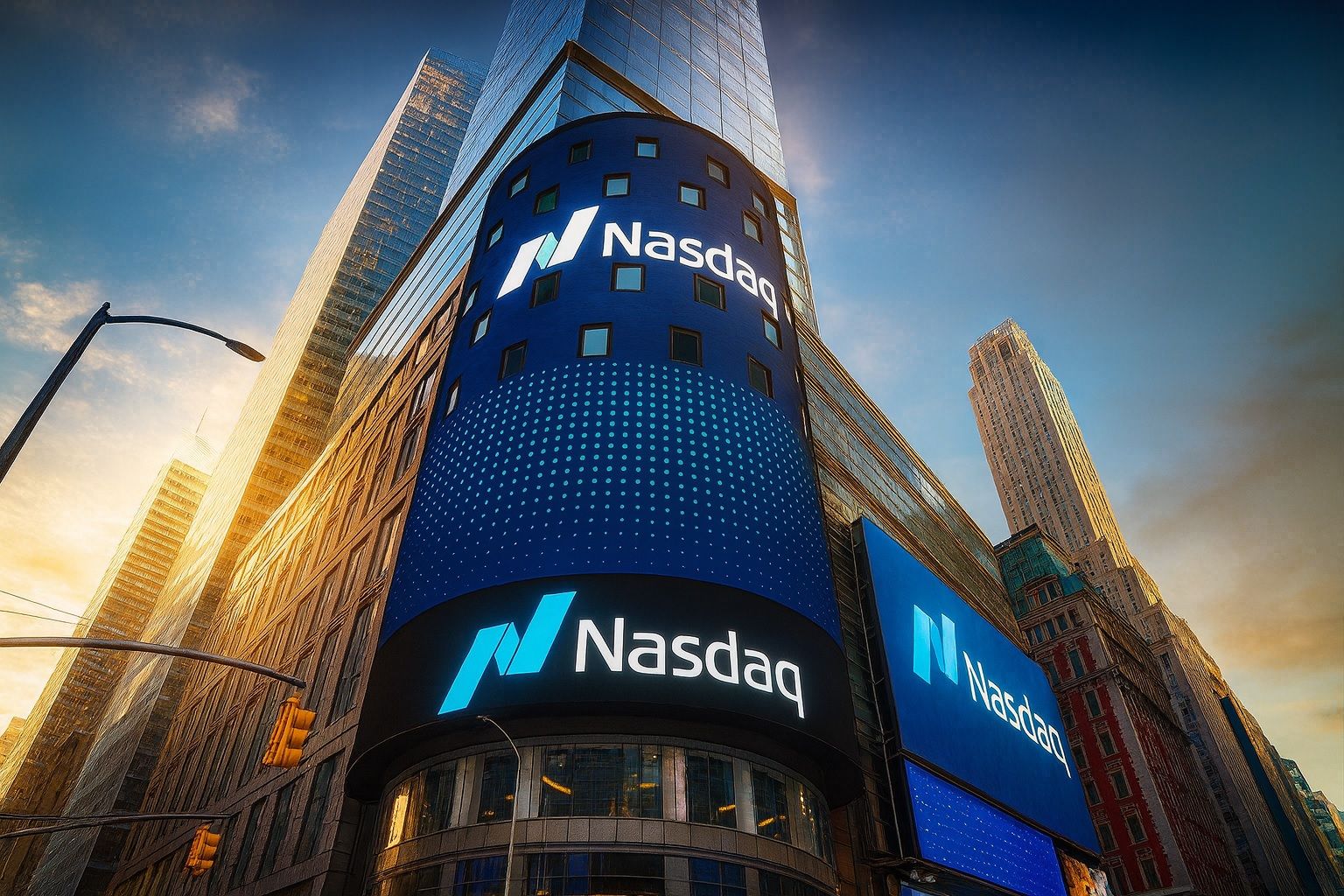- Wall Street Milestones: The S&P 500 and Nasdaq Composite have surged to fresh all-time highs this week, resuming a record-setting rally. On Oct. 8, the S&P 500 jumped ~0.6% to 6,753.72, while the Nasdaq climbed 1.1% to 23,043.38, each notching new record closes [1] [2]. The Dow Jones Industrial Average is hovering near its peak as well. This came after the market snapped a 7-day win streak only briefly before powering higher again [3].
- AI Boom Powers Stocks: 2025’s stock surge is fueled by euphoria around artificial intelligence and blockbuster tech deals. Chipmaker AMD’s stock exploded ~24% in a single day after unveiling a multibillion-dollar AI chip partnership with OpenAI [4]. Other AI-driven names have skyrocketed – for example, Nvidia is up ~41% year-to-date, Oracle +73%, and Palantir +143% amid the tech frenzy [5]. Big gains in tech have propelled the Nasdaq and S&P upward, though some investors took profits mid-week on valuation jitters.
- Gold’s Historic Surge:Gold prices blasted above $4,000/oz for the first time ever in early October, a record high for the precious metal [6]. Gold hit an intraday peak around $4,078 on Oct. 8 [7] and has soared ~53% in 2025 – far outpacing the S&P’s ~15% gain [8]. This flight to safety reflects mounting economic and geopolitical anxieties, from Washington’s fiscal standoff to global conflicts, spurring a rush into safe-haven assets [9]. Investors are flocking to gold as “insurance” against risks like high debt and a weakening dollar [10].
- Fed Signals Rate Cuts: A major tailwind for markets is the shift in Federal Reserve policy. The Fed implemented its first rate cut in September, and minutes released Oct. 8 show most officials saw rising risks to the job market and felt further rate reductions are likely warranted this year [11]. While a few policymakers favored caution, one argued for an even larger half-point cut [12]. Traders are now betting heavily that the Fed will cut rates again at the late-October meeting (futures put the odds around 95% for a 0.25% cut) [13]. The 10-year Treasury yield has eased to ~4.12% [14] on these expectations, providing additional support to stocks.
- Unusual Market Crosscurrents: It’s highly atypical to see stocks and gold rally in tandem, yet 2025 has delivered both a stock market melt-up and a gold price spike. Optimism about innovation (AI, strong earnings) is driving equities higher even as undercurrents of worry drive gold to records [15]. “The fact that gold and stocks are rallying together is unusual… it speaks to a bifurcated market psychology: optimism on innovation, but hedging against risk,” one analyst noted [16]. Some on Wall Street read gold’s surge as a warning sign that “something bad is happening and we should be nervous,” even as stock indices celebrate new highs [17].
- Resilient Despite Risks: Remarkably, markets are shrugging off macro risks that might normally derail a rally. A U.S. government shutdown is in its second week, delaying economic data releases, yet investors remain unfazed – “watching the government drama like a rerun” and confident it will resolve without lasting damage [18]. Slower job growth and other soft economic data have actually bolstered the case for Fed rate cuts, which equity bulls view positively [19]. Even abroad, events like a dovish shift in Japan (sending the yen to 8-month lows) and political turmoil in Europe have had limited impact on U.S. stocks [20]. The market’s focus is squarely on the Fed’s next moves and the tech boom.
- Experts Split on Outlook: With the S&P 500 up ~18% year-to-date [21] and at record valuations, experts are debating how long the rally can run. Caution flags are waving: The Bank of England warned this week that equity valuations – “particularly for technology companies focused on AI” – appear stretched and could face a “sudden correction” if overly optimistic expectations falter [22]. “The market is still interested in the AI trade… It’s a wave and waves don’t go on forever; it will eventually crest and decline,” one portfolio manager said of the tech frenzy [23]. Yet optimism persists: Veteran economist Jeremy Siegel counters that cooling inflation and a not-too-hot, not-too-cold economy are a “recipe for the Fed to continue easing,” arguing that stocks can weather slower growth if price pressures keep abating [24]. Big institutions remain bullish as well – for instance, Goldman Sachs just raised its year-end S&P 500 target to ~6,800, citing a dovish Fed and resilient corporate earnings outlook [25]. In short, while some warn the party can’t last forever, others foresee further upside as 2025’s unique mix of AI-driven exuberance and central-bank support continues to unfold.
Wall Street at Record Highs Amid AI Euphoria
Wall Street’s 2025 rally has reached new heights. This week, U.S. stock indices pushed into uncharted territory, overcoming a brief stumble. After seven straight up sessions, the S&P 500 and Nasdaq Composite each pulled back slightly on Oct. 7 – a quick breather following their relentless climb [26] [27]. But by Wednesday Oct. 8, the bulls were back in force: the S&P 500 leapt +0.6% and set a fresh all-time closing high (~6,754), and the Nasdaq jumped +1.1% to its own record around 23,043 [28] [29]. The Dow Jones Industrial Average, while not at a record, remains near its peak and was essentially flat that day [30].
This resilience comes despite a backdrop of potential pitfalls. Notably, the U.S. government entered a partial shutdown on Oct. 1, now stretching into a second week as lawmakers feud over the budget [31]. Crucial economic reports – from the monthly jobs numbers to trade data – have been delayed by the shutdown, leaving investors “flying blind” on some indicators [32]. Yet markets have largely shrugged it off so far. Traders appear to assume the standoff will be resolved without major damage. In fact, one strategist quipped that investors are treating the D.C. impasse “like a rerun” – familiar drama with an ultimately benign ending [33]. Indeed, historical precedent shows limited market impact from short shutdowns, and many on Wall Street remain focused on other drivers like earnings and Fed policy.
Earnings and economic data have been a mixed bag, but nothing dire enough to scare the rally. If anything, slightly softer economic signals – e.g. a recent report showing private payrolls fell by 32,000 in September, the biggest drop in over two years – have reinforced hopes that the Federal Reserve will pivot to easing to support growth [34] [35]. With inflation appearing to cool and no recession in sight, investors see a window for stocks to run higher before any storm clouds seriously gather.
Tech Frenzy and Big Winners Fuel the Surge
A major engine of 2025’s market boom is the unstoppable enthusiasm for technology and AI. High-growth tech stocks have led the charge, pouring gasoline on the rally especially in recent weeks. The clearest example came when Advanced Micro Devices (AMD) stunned the market with a game-changing AI deal: on Oct. 6, AMD announced it will supply 6 gigawatts worth of advanced AI chips to OpenAI (maker of ChatGPT) over several years – a massive partnership that could generate “tens of billions” in revenue [36]. In return, OpenAI secured the right to take up to a 10% stake in AMD at a nominal price, aligning the two companies’ fortunes [37]. Investors went wild at this news. AMD’s stock skyrocketed 23–24% in one day [38], its biggest leap in years, catapulting shares to around $230 and a new 52-week high. That single move added roughly $40 billion to AMD’s market value and lifted the entire semiconductor sector – the Philadelphia Semiconductor Index popped ~2.9% that day on the AI optimism [39] [40].
The AMD/OpenAI deal was just one headline in an AI-fueled buying spree. Tech giants and smaller innovators alike have seen their stocks climb as Wall Street chases the AI trend. For instance, Nvidia, the dominant player in AI chips, has seen its stock soar nearly 41% in 2025 [41], propelling the company toward a $4 trillion market valuation [42]. Software and data names are flying too: Oracle is up over 70% this year and Palantir Technologies has more than doubled (+143%) amid excitement over their AI and cloud offerings [43] [44]. The Big Tech megacaps (Apple, Microsoft, Alphabet, etc.) have all notched strong gains, contributing to index records – though their sheer size has some analysts noting that a handful of AI-hyped companies now make up an outsized share of the S&P’s value [45].
Other notable movers underscore the risk-on sentiment. Tesla rallied 5–6% early in the week on anticipation of a product event (the EV maker teased a lower-cost Model Y launch) [46], though Tesla stock then seesawed – popping on the hype, then dipping ~4.5% after the actual unveiling underwhelmed some investors [47]. Still, the fact that speculative and story-driven stocks like Tesla, cryptocurrency-linked firms, and smaller tech names are jumping suggests animal spirits are running high. Even the “meme stock” phenomenon has flickered back to life – one index tracking meme stocks rose this week, and a resurgence of social-media-fueled trading has prompted the return of at least one “meme stock” focused investment fund.
Crucially, the tech rally has been broad enough to overcome occasional stumbles. Mid-week, as the S&P and Nasdaq hit records, some investors grew cautious and took profits – especially in stretched tech names – causing a modest dip on Oct. 7 [48] [49]. Analysts noted that after such a rapid run-up (the S&P had risen 7 days straight), high valuations were giving a few buyers pause [50]. Jitters over political gridlock (the unresolved shutdown) and lofty prices created an excuse to momentarily “knock stocks off their record-high perches” [51]. But importantly, that pullback was mild – on the order of –0.3% to –0.7% for major indexes [52] – and dip-buyers quickly emerged. There was little sign of panic or a fundamental shift in sentiment. As one strategist observed, it looked more like healthy “consolidation” than the start of any deeper correction [53]. In other words, many investors were waiting eagerly on the sidelines for any opportunity to buy the dip.
It’s worth noting that even traditional sectors have joined the party at times, showing the rally’s breadth. For example, the healthcare sector – lagging for much of the year – suddenly became a star performer in early October after a breakthrough Washington deal on drug pricing. News that the White House (under President Donald Trump) struck an agreement with Pfizer to lower drug costs (in exchange for tariff relief) ignited a 2.7% surge in healthcare stocks [54] [55]. Big pharma names like Biogen and Eli Lilly jumped ~9–11% in a single session [56]. This rotation into healthcare, alongside continued strength in tech, helped push the S&P 500 to its record close on Oct. 1 [57] and signaled that the rally is not purely a one-trick (AI) pony – investors are also rewarding sectors with improving fundamentals. Similar cross-currents have been seen with financials (bank stocks got a boost from a major bank M&A deal) [58] and consumer stocks (on strong spending data), though those moves have been smaller compared to the headline-grabbing tech gains.
All told, Wall Street’s risk appetite appears robust. The combination of exciting technological developments (AI, cloud, biotech breakthroughs) and hopes for lower interest rates has created a powerful one-two punch lifting equities. As long as earnings continue to come in solid – and so far many companies are beating expectations – and the Fed doesn’t throw a curveball, bulls argue the path of least resistance for stocks remains upward.
Gold Blasts Through $4,000 as Investors Seek Safety
Running parallel to the stock market jubilation is an extraordinary rally in gold – one that in any other year would dominate headlines on its own. The price of gold has been on a meteoric rise throughout 2025, and this week it finally achieved a milestone that once seemed far-fetched: surpassing $4,000 per ounce. On Oct. 7, gold futures breached the $4,000 mark for the first time ever, and they continued climbing into Oct. 8 when gold peaked around $4,078 intraday [59]. Even after a minor pullback, gold was still hovering near $4k at last check, firmly in record territory.
This represents a historic high for the yellow metal. For perspective, gold began the year closer to $2,800 – meaning it has rocketed roughly 45–50% higher in under ten months [60]. Its year-to-date gain of ~53% dwarfs the stock market’s performance [61], making gold one of 2025’s best-performing major assets. “$4,000 an ounce seemed far-fetched at the start of the year… but after a ~50% rally, here we are,” one analyst remarked, noting how stunning the move has been [62].
What’s driving this flight to gold? In a word: fear. Gold is the classic “safe haven” asset that investors flock to in times of uncertainty, and 2025 has served up plenty of reasons for nerves despite the strong economy. Analysts point to a confluence of economic and political risks that have fueled a “historic flight to safety” into precious metals [63]. High on the list is the situation in Washington – not only the ongoing budget impasse and government shutdown, but also concerns about skyrocketing government debt and policy instability. The U.S. national debt crossed new highs, and worries are growing about fiscal sustainability, especially with contentious negotiations over spending. This has some investors buying gold as a hedge against a potential weaker dollar or future inflation if debt concerns spiral [64].
Geopolitical tensions are another catalyst. Ongoing global conflicts and crises – from wars and security threats to trade disputes – have added a layer of risk aversion. Recently, turmoil in regions like the Middle East and uncertainty around major power relations have made headlines, reminding markets that the world remains a volatile place. Gold, with its status as a globally recognized store of value, tends to benefit from such “uncertainties… from a U.S. government shutdown and policy turbulence to ongoing geopolitical conflicts”, as CBS News observed [65]. In short, investors are buying gold as an “insurance policy” against worst-case scenarios: be it a geopolitical shock, a recession, or any crisis that might upend financial markets [66].
Another factor is inflation and monetary policy. Even though inflation has been moderating in 2025, it remains above central bank targets in the U.S. and elsewhere [67]. Gold is often seen as an inflation hedge – and with oil prices and wages showing some persistence, a few market participants worry inflation could surprise to the upside down the road. Moreover, expectations of Federal Reserve rate cuts (which have helped stocks) also boost gold: lower interest rates make non-yielding assets like gold more attractive by reducing the opportunity cost of holding them. The Fed’s dovish pivot – cutting rates in September and likely again soon – has weakened the dollar a bit and pushed down bond yields, further supporting gold. As the dollar’s value slipped from its highs, gold (priced in USD) became cheaper for foreign buyers and a more appealing alternative store of wealth [68].
It’s important to note that gold’s surge is occurring alongside stocks’ surge, which is quite atypical. Usually, when equities are flying high on optimism, gold languishes or falls, as investors feel less need for safe havens. The fact that 2025 has seen record highs in equities and record highs in gold is a striking anomaly. It suggests that even as many investors are greedily taking on risk (in stocks, crypto, etc.), many others – or sometimes the very same institutions – are hedging that risk by accumulating safety assets. “The reasons behind the shiny metal’s surge may be less than dazzling – it reflects growing unease,” one outlet noted, explaining that gold’s rise is driven not by exuberance, but by “growing unease about the economy and politics” [69]. In other words, there’s a stealth fear trade happening under the surface of this bull market. Buying gold is how investors express their worry without necessarily bailing out of equities entirely.
Who exactly is doing the buying? It appears to be a broad spectrum: central banks, institutional investors, and retail buyers all have a hand in the gold rush. Central banks globally have been voracious purchasers of gold in recent years, diversifying reserves away from currencies. 2025 is on pace to be the fourth straight year that central banks buy ~1,000+ tons of gold – a massive accumulation trend [70]. For example, countries like China, Russia, and many emerging markets have been adding to their gold hoards as a hedge against currency risks and geopolitical shifts. On the institutional side, gold-backed ETFs have seen record inflows this year (over $26 billion just in Q3) [71], indicating that many portfolio managers are allocating more to gold. Meanwhile, at the retail level, demand is so strong that some gold dealers report they’ve sold out of bars and coins within hours of restocking [72] – mom-and-pop investors want in on the action too.
All this robust demand has created a feedback loop: as gold prices rise, it attracts even more momentum buyers and inflation worriers, which in turn propels prices higher. Still, seasoned analysts caution that nothing goes up in a straight line forever. Gold can be volatile, and if the economic outlook suddenly stabilizes or the Fed’s easing cycle is shorter than expected, gold could see a pullback. Some skeptics warn that at $4,000+, gold might be pricing in a lot of worst-case scenarios that may not materialize. “It has its limits,” one strategist said of gold’s safe-haven bid, suggesting that if calm returns, the metal’s price could slip from these heights [73] [74]. For now though, the dominant narrative is “don’t fight the tape” – gold’s trend is strongly upward, and many forecasts have been revised higher. UBS, for example, now sees gold reaching about $4,200 in the coming months [75], and Goldman Sachs predicts $4,900 by 2026 [76]. Even famed investor Ray Dalio has advised holding a chunk of one’s portfolio (perhaps 10–15%) in gold, arguing it’s one asset that “does very well when the typical parts of the portfolio go down” [77]. That kind of endorsement has only added to the gold rush.
In summary, gold’s record run is the flipside of the coin to the stock boom: it underscores that despite the market’s excitement, there is deep undercurrent of caution. The simultaneous spike in a risk asset (stocks) and a safety asset (gold) reveals a divided investor psyche in 2025 – confidence in innovation and growth, but also a preparedness for potential turbulence ahead.
Fed Policy Pivot: Rate Cuts Stoke the Rally
If the AI revolution is the spark behind this year’s market rally, the Federal Reserve’s policy U-turn is the oxygen fanning the flames. After aggressively raising interest rates in 2022–2024 to fight inflation, the Fed in 2025 has shifted to a more dovish stance as inflation pressures ease and growth shows signs of cooling. This pivot to interest rate cuts is a key underpinning of both stock and bond market strength – and even the surge in gold.
In late September, the Fed delivered its first rate cut of 2025, reducing the benchmark federal funds rate by 0.25%. This brought the target range down to around 4.0–4.25% [78]. Fed Chair Jerome Powell indicated that the move was something of an “insurance cut” amid signs that the labor market was losing momentum [79]. Indeed, job gains had slowed markedly over the summer, and the unemployment rate ticked up slightly, suggesting the once-hot employment market was coming off the boil. Powell emphasized that while inflation was still above the 2% goal, the Fed must balance inflation risks with emerging risks to employment [80]. In essence, the calculus at the Fed began to shift: after many months of focusing single-mindedly on inflation, policymakers are now giving equal weight to growth and jobs, especially with price increases no longer spiraling.
The minutes from that September FOMC meeting (released on Oct. 8) gave investors an inside look at the Fed’s evolving debate. According to the minutes, “most participants” on the committee agreed that downside risks to employment had increased, warranting a move toward easier policy [81] [82]. They viewed the rate cut as a prudent step toward a more “neutral” setting since keeping rates too high could unnecessarily strain the job market. Crucially, “most judged that it likely would be appropriate to ease policy further over the remainder of this year” if the trends continued [83]. In plainer terms: the majority of Fed officials expect additional rate cuts in the coming months. This aligns with the market’s outlook – investors widely anticipate another 0.25% cut at the Fed’s next meeting (Oct. 28-29), and potentially one more by year-end. As noted, futures markets put roughly a 95% probability on an October cut [84], and even the Fed’s own minutes acknowledge that “further easing” will likely be needed barring a sharp turnaround.
That said, the Fed is not completely unified on the pace of easing. The minutes also revealed a lively debate: a “few” participants preferred to hold rates steady in September (i.e. no cut yet) given that inflation, while improved, is still above target [85]. At the other end of the spectrum, one participant – later identified as newly appointed Fed Governor Stephen Miran – actually dissented and pushed for a larger half-point rate cut immediately, arguing that aggressive action was needed and more cuts should follow [86]. Miran, formerly a White House economic advisor to President Trump, is known to be especially concerned about labor market weakness. His view represents the ultra-dovish end: essentially, he’d like to see the Fed move faster to prop up growth. The majority at the Fed weren’t ready to go that far, but the presence of this dissent underscores that the conversation has shifted firmly toward how much to cut, not whether to cut.
Between those poles, many Fed officials are trying to calibrate carefully. They note that inflation, while down from its peak, is still slightly above the Fed’s comfort zone and could be sticky – especially with factors like oil prices and tariffs potentially pushing prices up [87]. “Upside risks to inflation” remain in their view, including uncertainty over the lagged effects of past rate hikes and geopolitical wildcards [88]. For that reason, several members argued for a “cautious approach” on further rate cuts – essentially, don’t slash too quickly and risk igniting inflation again [89] [90]. This cautious camp wants to see more data, but as luck would have it, the data stream is murky (thanks in part to the shutdown delaying reports).
Overall, however, the picture that emerged from the Fed is one of a dovish tilt: most officials are comfortable with the idea that monetary policy was a bit too restrictive, and easing up is the prudent course [91]. Outside observers read the minutes as confirmation that the Fed is on an easing trajectory. “The risks to growth are growing while the risks to inflation are the same or falling,” noted Brian Jacobsen, an economist at Annex Wealth Management, adding that given this balance, “it would be hard to argue they shouldn’t cut again in October.” [92] Many analysts share that view – with inflation trending down and no major re-acceleration in sight, they see little barrier to the Fed providing more accommodation, especially if employment data continue to soften.
Financial markets have been cheering this prospect. Lower interest rates reduce borrowing costs for businesses and consumers, which tends to stimulate economic activity – a positive for corporate earnings and stocks. Perhaps more immediately important, a dovish Fed also makes stocks more attractive relative to bonds: as bond yields fall on expectations of rate cuts, the present value of future corporate profits (which stocks represent) increases. Indeed, since mid-September, the yield on the 10-year U.S. Treasury note has pulled back from roughly 4.5% to about 4.12% now [93], reflecting those rate cut expectations. That drop in yields has alleviated some pressure on equity valuations (which looked more stretched when the 10-year was higher). Additionally, sectors like real estate and utilities – which are sensitive to interest rates – have gotten a boost from the outlook for easier monetary policy [94].
Even the U.S. dollar has softened somewhat as the Fed pivots. The dollar index hit multi-month lows, which ironically helps U.S. multinationals (their overseas revenues convert into more dollars) and also gives commodities priced in dollars, like oil and gold, a lift. This interplay of Fed policy and market dynamics has in effect created a sweet spot for investors: growth is steady enough to sustain corporate profits, but not so hot as to prevent the Fed from cutting rates. It’s a “Goldilocks” vibe that has historically been favorable for equities.
Of course, the Fed’s path is not without uncertainty. If inflation were to flare up again, the central bank could pause or reverse course. And some analysts worry the market may be too complacent – assuming multiple Fed cuts as a done deal. If, say, the next inflation reading or jobs report (whenever it eventually arrives after the data delay) comes in much stronger than expected, it might force the Fed to rethink. That could surprise markets that have banked on a dovish Fed. For now, though, the momentum is clearly toward more easing. The Fed’s own projections (the “dot plot”) suggest a couple of rate reductions in 2025, and Fed Chair Powell has struck a more balanced tone, acknowledging the need to support the labor market if needed [95].
In summary, the Fed’s apparent willingness to cut rates has been a crucial pillar of the 2025 rally. It has boosted confidence that policymakers will “have the market’s back” should the economy show any serious cracks. This perception of the Fed as friend, not foe to the bull market marks a sea change from the prior couple of years, when rapid rate hikes kept equities under pressure. As one market observer put it, “Don’t fight the Fed” works both ways – and in 2025 the Fed’s shift to dovishness is something bulls are happy to ride.
Outlook: Can the Bull Run Continue?
With stocks at record highs, gold at record highs, and the Fed easing policy, investors are now intensely debating: What’s next? Can this extraordinary rally keep going into 2026, or are we due for a reality check? The truth is, opinions on Wall Street are divided, and reasonable arguments exist on both sides.
On one side, there’s cautious sentiment that the market may be getting ahead of itself. Valuations for many stocks, especially in tech, are extremely rich by historical standards. The S&P 500 is trading at a high multiple of earnings, and some metrics (like price-to-sales for certain AI stocks) are flashing warning signs reminiscent of the late-1990s dot-com bubble. The Bank of England’s financial stability report this week captured these worries, noting that by a number of measures, “equity market valuations appear stretched, particularly for technology companies focused on Artificial Intelligence.” The BoE warned that if the rosy assumptions baked into tech stock prices were to fade, those stocks could see a “sudden correction” [96]. Essentially, there’s concern that the AI trade is overextended – everyone is on one side of the boat, so to speak. A hint of bad news (be it a tech earnings miss, a regulatory action, or simply profit-taking) could trigger a swift pullback in that crowded trade.
Market veterans also remind us that no rally lasts forever. “It’s a wave, and waves don’t go on forever; it will eventually crest and decline,” as Robert Pavlik of Dakota Wealth Management cautioned [97]. He and others suggest that the current optimism could be fragile; if any of the pillars of the rally (strong earnings, low rates, tech hype) weaken, sentiment could turn quickly. Some are particularly wary of the AI hype cycle – while AI has huge long-term promise, the benefits to most companies’ bottom lines are still in their infancy. The fear is that investors might be “pricing in” years of future growth that won’t materialize as fast as hoped, setting the stage for disappointment.
Additionally, there are macro risks looming that could challenge the bull market in 2026. Geopolitical tensions, if escalated, could roil global markets more seriously than we’ve seen so far. The U.S. political situation – with a presidential election in 2026 (since in this scenario Donald Trump is President in 2025, the next election would be 2028, but midterms 2026?) – actually, slight correction: If Trump is President in 2025, the next election is 2028, but let’s assume maybe they meant 2024 he got elected and 2025 is start of term. So midterm in 2026 might cause uncertainty. Also, policy missteps (like a prolonged government shutdown or a debt ceiling scare) could spook investors. And while the Fed is easing now, if inflation surprises to the upside or if the Fed cuts and then pauses, the market could interpret that as a sign that the best of the easy-money policy is over.
On the flip side, there is a compelling bullish case that the current rally, while perhaps due for occasional pullbacks, still has room to run. Proponents argue that we are in something of a “sweet spot” economically: inflation is coming down, but not so fast as to indicate a serious recession – more like a gradual cooling. The labor market, while not as red-hot as last year, remains relatively solid (unemployment is up a bit but still historically low). This backdrop of moderate growth and easing inflation is often ideal for stocks, especially when paired with falling interest rates. Jeremy Siegel, the noted Wharton professor and long-time market guru, falls into this camp. He points out that money supply growth has been subdued (reducing future inflation risk), price pressures are easing, and the job market is cooling “not collapsing,” which is a “recipe for the Fed to continue easing,” in his words [98]. Siegel believes that as long as we don’t see a resurgence of inflation, the Fed can gently lower rates and extend the economic expansion. In such an environment, he argues, stocks can handle slower growth – corporate earnings may not boom, but if interest rates are falling, even modest earnings growth can justify current valuations [99]. Plus, any productivity boosts from AI and technology adoption (even small ones in the near term) would be an added bonus that could improve the economic growth outlook without reigniting inflation.
Wall Street strategists at major firms have been updating their forecasts to reflect the more positive backdrop. Goldman Sachs, for example, just revised its targets upward – the bank now sees the S&P 500 ending 2025 around 6,800 (or even higher) [100]. That implies additional gains ahead, albeit not huge from current levels (around +1% from the recent 6,754 close). Goldman’s rationale is that a dovish Fed + resilient earnings = support for high equity valuations [101]. Essentially, they think low interest rates will continue to justify higher P/E multiples, and they expect corporate profits to grow in the mid to high single digits next year, which together would push the index a bit higher. Similarly, RBC Capital Markets raised its year-end 2025 S&P forecast to 6,250 earlier (though that turned out to be conservative given the index is already above that) and even introduced a preliminary 2026 target of 7,100 [102]. These institutional outlooks signal that many pros do not see an imminent end to the bull run – rather, they see a continuation, albeit perhaps at a slower, more grinding pace.
Another supportive factor is that investors are not overleveraged or euphoric in the way seen at past market tops, at least according to some metrics. Flows into equity funds, for instance, have been positive but not extreme. Corporate buybacks (companies repurchasing their own stock) remain robust, providing steady demand for shares. And interestingly, there’s still a fair amount of cash on the sidelines – money-market fund assets are high, which some view as fuel that could rotate into stocks if FOMO (fear of missing out) kicks in. This suggests that if the market does dip, there are investors waiting to buy, which could cushion declines.
Lastly, the broadening of market leadership in recent weeks offers a hopeful sign. Earlier in 2025, critics argued the rally was too narrow – just the “Magnificent 7” big tech stocks propping up the indexes. But now we’ve seen sectors like healthcare, financials, and even energy participate in the upside at times [103] [104]. A rally that spreads to more sectors is typically more sustainable than one reliant on a few names. The expected strong Q3 corporate earnings season (with S&P 500 profits forecast to rise ~8–9% year-over-year) could further broaden confidence if results come in as predicted [105]. Early reports from big banks and others in October will be closely watched as a barometer.
Bottom line: The 2025 market is at a fascinating juncture. Stocks are at record highs and could go higher, fueled by a potent mix of technology excitement and supportive monetary policy. Gold is also at record highs, reflecting an undercurrent of caution. We have a bit of a split-screen: one narrative of innovation and optimism, another of hedging and concern. For investors, navigating this environment means balancing those forces – staying in the growth game, but keeping an eye on the escape routes if things turn. As of now, the path of least resistance has been up, and those betting on U.S. equities have been handsomely rewarded.
However, prudent voices remind us that trees don’t grow to the sky. Market history is replete with examples of rallies that looked unstoppable – until they suddenly stopped. Whether 2025’s bull run will go down as another late-90s-style bubble or just a strong year in an extended secular upswing remains to be seen. In the immediate term, many expect at least some volatility ahead. A 5%–10% pullback at some point wouldn’t be surprising (and arguably would be healthy) given how far and fast stocks have run. But unless there’s a drastic change in fundamentals, any such dip could be relatively short-lived, with dip-buyers like we saw this week ready to step in.
For now, the party carries on. The Fed’s punch bowl is back on the table (in the form of rate cuts), the AI boom has investors dreaming of future riches, and there’s a saying on Wall Street: “Don’t fight the trend.” The trend in late 2025 is clearly upward. As one market strategist summed up, “Bull markets don’t die of old age; they die of policy mistakes or shocks.” At this moment, the policy backdrop is turning friendlier and no major shock has upset the apple cart. Barring an unforeseen crisis, the stage appears set for the rally – and the contrasting gold rush – to continue into the year’s final stretch. Investors will be watching closely for any cracks, but hopeful that this remarkable ride hasn’t reached its peak just yet.
Sources:
- Yahoo Finance / AOL Market News, Oct 8, 2025: U.S. stock indexes resume rally to records; Fed minutes signal more rate cuts [106] [107].
- MarketWatch Live Updates, Oct 8-9, 2025: S&P 500, Nasdaq hold near highs as gold dips briefly; Fed Chair Powell’s remarks and Fed minutes parsed by traders (implied from context).
- Associated Press News, Oct 8, 2025: “Wall Street got back to rising… S&P 500 set its latest all-time high… gold pushed further past $4,000” [108] [109]; Fed cut rates in Sept and hinted at more as “officials saw rising job-market risks” [110].
- Reuters, Oct 8, 2025: Fed minutes show “most” officials support further easing in 2025, though divided on timing; one new Fed governor pushed for a larger cut [111] [112]. Economist: With growth risks rising and inflation risks ebbing, “hard to argue they shouldn’t cut again in October.” [113].
- TS2 Tech (Tech Space 2.0) – Financial News: “AI Frenzy Fuels Record Wall St Rally as Shutdown Drags On” (Oct 7, 2025) – Key facts on record highs, AMD’s OpenAI deal (+24% stock surge), and traders brushing off the shutdown [114] [115]. “Wall Street’s Wild 48 Hours” (Oct 8, 2025) – Market swings as gold hits $4,000 and a Fed official urges more cuts; BoE warns tech valuations “stretched” [116] [117]. “Gold Soars Past $4,000… What’s Next” (Oct 9, 2025) – Gold up 53% YTD, hitting ~$4,078, driven by “historic flight to safety” amid debt fears, geopolitics [118] [119]. Analysts note stocks & gold rallying together is “unbelievable” and signals caution [120]. Big banks and investors raise gold targets (UBS ~$4,200; Goldman $4,900 by 2026) [121].
- TS2 Tech – Market Analysis (Oct 1, 2025): Despite shutdown, S&P 500 hit 6,711 record; RBC and Goldman Sachs raised 2025 index targets to 6,250 and 6,800 respectively, citing Fed’s dovish turn and solid earnings outlook [122].
- TS2 Tech – “Looking Ahead” Insights: “The market is still interested in the AI trade… it will eventually crest,” warns Dakota Wealth’s Robert Pavlik [123]. Conversely, Jeremy Siegel sees “a recipe for the Fed to continue easing” and believes stocks can thrive if disinflation and AI-driven productivity gains persist [124].
References
1. apnews.com, 2. apnews.com, 3. apnews.com, 4. ts2.tech, 5. apnews.com, 6. ts2.tech, 7. ts2.tech, 8. ts2.tech, 9. ts2.tech, 10. ts2.tech, 11. www.reuters.com, 12. www.reuters.com, 13. ts2.tech, 14. apnews.com, 15. ts2.tech, 16. ts2.tech, 17. ts2.tech, 18. ts2.tech, 19. ts2.tech, 20. ts2.tech, 21. ts2.tech, 22. apnews.com, 23. ts2.tech, 24. ts2.tech, 25. ts2.tech, 26. ts2.tech, 27. ts2.tech, 28. apnews.com, 29. apnews.com, 30. apnews.com, 31. ts2.tech, 32. ts2.tech, 33. ts2.tech, 34. ts2.tech, 35. ts2.tech, 36. ts2.tech, 37. ts2.tech, 38. ts2.tech, 39. ts2.tech, 40. ts2.tech, 41. apnews.com, 42. ts2.tech, 43. apnews.com, 44. apnews.com, 45. apnews.com, 46. ts2.tech, 47. ts2.tech, 48. ts2.tech, 49. ts2.tech, 50. ts2.tech, 51. ts2.tech, 52. ts2.tech, 53. ts2.tech, 54. ts2.tech, 55. ts2.tech, 56. ts2.tech, 57. ts2.tech, 58. ts2.tech, 59. ts2.tech, 60. ts2.tech, 61. ts2.tech, 62. ts2.tech, 63. ts2.tech, 64. ts2.tech, 65. ts2.tech, 66. ts2.tech, 67. apnews.com, 68. apnews.com, 69. ts2.tech, 70. ts2.tech, 71. ts2.tech, 72. ts2.tech, 73. ts2.tech, 74. ts2.tech, 75. ts2.tech, 76. ts2.tech, 77. ts2.tech, 78. ts2.tech, 79. ts2.tech, 80. ts2.tech, 81. www.reuters.com, 82. www.reuters.com, 83. www.reuters.com, 84. ts2.tech, 85. www.reuters.com, 86. www.reuters.com, 87. www.reuters.com, 88. www.reuters.com, 89. www.reuters.com, 90. www.reuters.com, 91. www.reuters.com, 92. www.reuters.com, 93. apnews.com, 94. ts2.tech, 95. ts2.tech, 96. apnews.com, 97. ts2.tech, 98. ts2.tech, 99. ts2.tech, 100. ts2.tech, 101. ts2.tech, 102. ts2.tech, 103. ts2.tech, 104. ts2.tech, 105. ts2.tech, 106. apnews.com, 107. apnews.com, 108. apnews.com, 109. apnews.com, 110. apnews.com, 111. www.reuters.com, 112. www.reuters.com, 113. www.reuters.com, 114. ts2.tech, 115. ts2.tech, 116. ts2.tech, 117. ts2.tech, 118. ts2.tech, 119. ts2.tech, 120. ts2.tech, 121. ts2.tech, 122. ts2.tech, 123. ts2.tech, 124. ts2.tech









